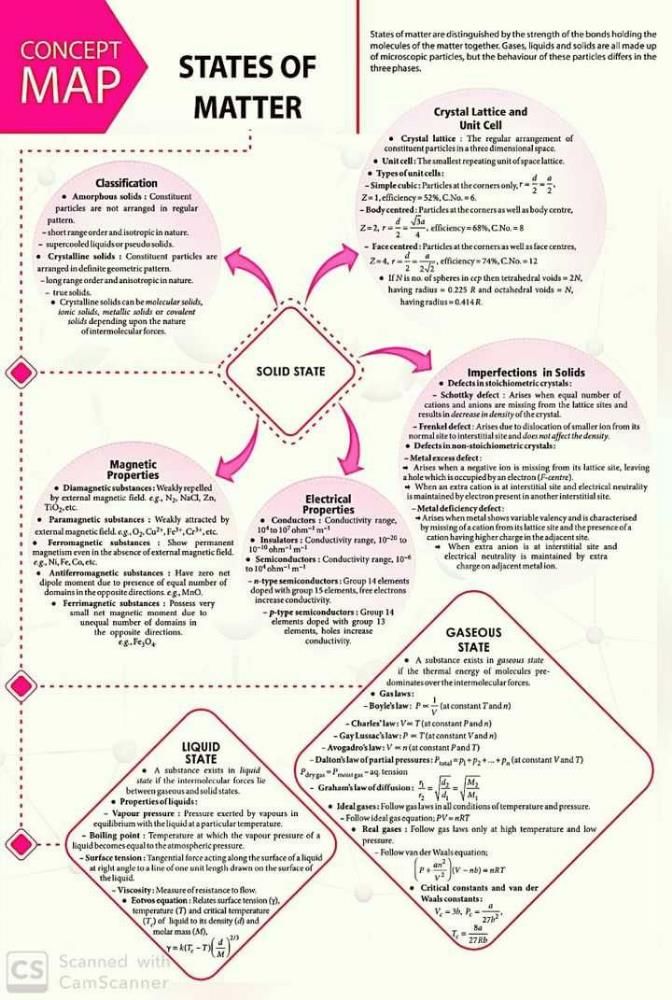Class 11 Exam > Class 11 Questions > Concept map for state of matter ?
Start Learning for Free
Concept map for state of matter ?
Community Answer
Concept map for state of matter ?
Concept Map for State of Matter
Introduction
State of matter refers to the physical form in which matter can exist, such as solid, liquid, or gas. Understanding the different states of matter is crucial in various scientific fields, including physics, chemistry, and engineering.
Three States of Matter
There are three primary states of matter:
- Solid: In this state, matter has a definite shape and volume. The molecules are tightly packed together and have minimal movement.
- Liquid: In this state, matter has a definite volume but takes the shape of its container. The molecules are loosely packed together and are free to move around.
- Gas: In this state, matter has neither a definite shape nor a definite volume. The molecules are widely spaced apart and move around freely.
State Transitions
Matter can undergo state transitions, which involve changing from one state of matter to another. These transitions include:
- Melting: The process of changing a solid to a liquid state through the addition of heat.
- Freezing: The process of changing a liquid to a solid state through the removal of heat.
- Evaporation: The process of changing a liquid to a gas state through the addition of heat.
- Condensation: The process of changing a gas to a liquid state through the removal of heat.
- Sublimation: The process of changing a solid directly to a gas state without going through the liquid state.
- Deposition: The process of changing a gas directly to a solid state without going through the liquid state.
Phase Diagrams
Phase diagrams are graphical representations of the state of matter of a substance at various pressures and temperatures. They show the points at which a substance undergoes a phase transition and can be used to predict the behavior of a substance under different conditions.
Conclusion
Understanding the different states of matter and their properties is crucial in various scientific fields. The ability to predict how matter will behave under different conditions is essential in fields such as material science, chemical engineering, and physics.

|
Explore Courses for Class 11 exam
|

|
Similar Class 11 Doubts
Question Description
Concept map for state of matter ? for Class 11 2025 is part of Class 11 preparation. The Question and answers have been prepared according to the Class 11 exam syllabus. Information about Concept map for state of matter ? covers all topics & solutions for Class 11 2025 Exam. Find important definitions, questions, meanings, examples, exercises and tests below for Concept map for state of matter ?.
Concept map for state of matter ? for Class 11 2025 is part of Class 11 preparation. The Question and answers have been prepared according to the Class 11 exam syllabus. Information about Concept map for state of matter ? covers all topics & solutions for Class 11 2025 Exam. Find important definitions, questions, meanings, examples, exercises and tests below for Concept map for state of matter ?.
Solutions for Concept map for state of matter ? in English & in Hindi are available as part of our courses for Class 11.
Download more important topics, notes, lectures and mock test series for Class 11 Exam by signing up for free.
Here you can find the meaning of Concept map for state of matter ? defined & explained in the simplest way possible. Besides giving the explanation of
Concept map for state of matter ?, a detailed solution for Concept map for state of matter ? has been provided alongside types of Concept map for state of matter ? theory, EduRev gives you an
ample number of questions to practice Concept map for state of matter ? tests, examples and also practice Class 11 tests.

|
Explore Courses for Class 11 exam
|

|
Signup to solve all Doubts
Signup to see your scores go up within 7 days! Learn & Practice with 1000+ FREE Notes, Videos & Tests.




























